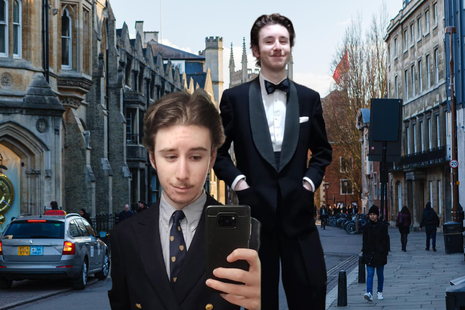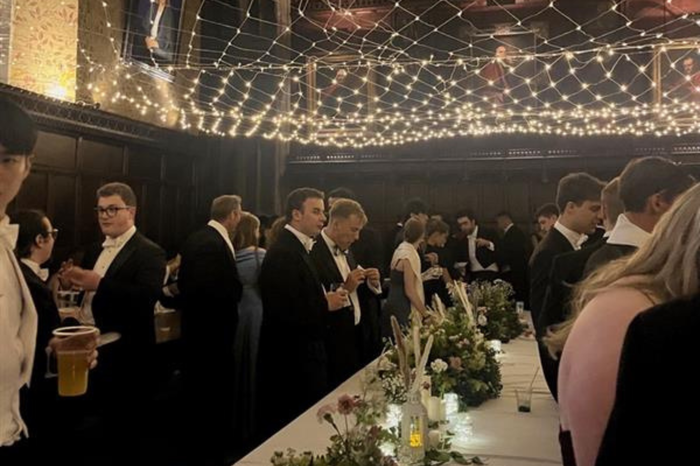Our all-inclusive guide to men’s formalwear
Worried about suiting your style to Cambridge’s formal dress codes? Worry no more, Hugh Jones has the guide for you

Are you an incoming fresher nervously wondering what to wear to Cambridge’s manifold formal social events? Are you a second, or even third-year, who has been muddling through with difficulty so far? Men’s formalwear can seem simpler than women’s, but it is hedged about with rules ostensibly designed to trip up the uninitiated. If you are worried about those traps, fear not, and read on: all will become clear.
Let’s start with formal daywear. You will see this referred to in dress codes as ‘business suits’, ‘lounge suits’ – or just ‘suits’. Whatever you call it, it should be plain wool, coloured dark blue or grey. You don’t want multiple colours and you definitely don’t want it to look ‘loud’. Any patterns should be subtle (think herringbone rather than houndstooth), and, as a rule of thumb, if you are standing more than three metres away, they should be invisible.
“As a rule of thumb, if you are standing more than three metres away, patterns should be invisible”
Check your chest and leg size before buying the suit if you don’t know them already; shop staff should be happy to help with this sort of thing. Avoid ‘slim-fit’ styles – suits are all about clean lines rather than being skin-tight. Aim for something which fits snugly, but not too tightly, on your shoulders. When buttoned it should drape over you without clinging too tightly or looking formlessly oversized. Only ever do up one button on a suit jacket – the middle if there are three buttons and the top if there are two. Your trousers should, again, be neither skin-tight nor baggy – think straight lines – and should just rest on the top of your shoe. They should also fit without the assistance of a belt – never wear a belt with a suit.
“Avoid ‘slim-fit’ styles – suits are all about clean lines rather than being skin-tight”
Wear the suit with black shoes, never brown shoes with a dark ‘town’ suit. These should ideally be Oxfords without broguing (decorative perforations in the shoe leather). Bonus points if they have a toe cap for added durability/formality. Like the suit, the shirt should be plain. The safest option is a white cotton shirt, without visible branding (save the Ralph Lauren for the weekend). Also try to avoid a button-down collar, which is too informal for most occasions which call for a suit. Pastel colours are also fine, as is some degree of patterning (white and blue stripes for example), but, just like with the suit jacket, avoid anything loud.
Ties are increasingly optional nowadays, but if in doubt it is safest to wear (or at least bring) one. Diagonal stripes are a good standard design, as are repeated rows of little symbols (these can be fun – little elephants, say) against a plain background. Wearing a college tie is absolutely fine, but, outside Cambridge, it involves the risk that you will look like a lost sixth-former – or like you are trying too hard to trade on the alumni network. If you plan to wear a tie, wear brass collar stiffeners with it if possible. Avoid bow ties, except with evening dress.
“If you plan to wear a tie, wear brass collar stiffeners with it if possible”
That’s all for daywear. You could probably wear that outfit to most formal evening events too, though I think that is regrettable – traditionally a strict distinction was kept between day and evening wear. That has mostly disappeared now, with the exception of black-tie events. For these, you need a specific black tie suit, known as a ‘dinner suit’, or simply as ‘evening dress’ (‘tuxedo’ is American). This is a suit, as above, except it is black, has satin lapels, may have only one button, and is (ideally) worn with black patent leather shoes. The trousers should have a black satin stripe running down the outside of each leg. It is worn with a white shirt, known as a ‘dress shirt’, which has either a thicker frontage covering the part of the chest visible through the jacket (personally I prefer this) or pleats in the same place. The former style may require shirt studs (like cufflinks, but replacing chest rather than cuff buttons). They look sharp but tend to go missing at crucial moments.
You also, famously, need a bow tie. This should be black (no exceptions) and hand-tied. If you don’t know how to tie a bow tie, Google it and allow plenty of time. With YouTube and a mirror, you will work it out. I would advise against a cummerbund – adding accessories does not make an outfit more smart (see belts above).
There is plenty to object to in all of this, I am sure. I have left crucial questions unanswered (Wing collar for black tie? Peak or notch lapel?) Some of the opinions I have offered may be controversial; you might well object to all these rules as ridiculous nonsense. Nonetheless, they exist, and if you’re going to break them, it should be on purpose. Most, however, will just want to enjoy their party, dinner, or interview without getting into sartorial trouble; hopefully, this guide will help you to do just that.
 News / Cambridge academics stand out in King’s 2026 Honours List2 January 2026
News / Cambridge academics stand out in King’s 2026 Honours List2 January 2026 Interviews / You don’t need to peak at Cambridge, says Robin Harding31 December 2025
Interviews / You don’t need to peak at Cambridge, says Robin Harding31 December 2025 Comment / What happened to men at Cambridge?31 December 2025
Comment / What happened to men at Cambridge?31 December 2025 News / Varsity’s biggest stories of 202531 December 2025
News / Varsity’s biggest stories of 202531 December 2025 Features / “It’s a momentary expression of rage”: reforming democracy from Cambridge4 January 2026
Features / “It’s a momentary expression of rage”: reforming democracy from Cambridge4 January 2026










